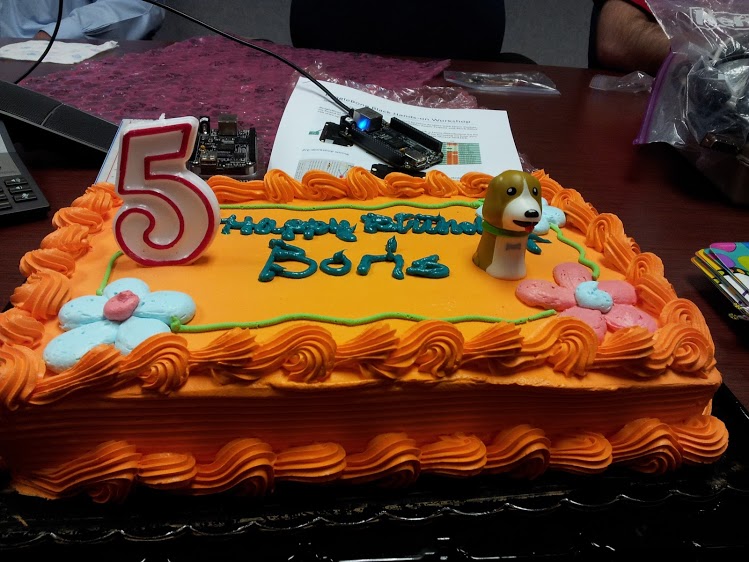It has been a busy week for BeagleBoard.org, which has now been around for five years!
Drew Fustini of Element14 was nice enough to bring cake to the Southeast Michigan Friends of
Boris (the Beagle) meet-up. A notable point of discussion was the
fact that BeagleBoard.org got its name from Gerald’s dog Jake, but yet the
cartoon mascot for BeagleBoard.org was named ‘Boris’ by Philip who paid to get
the logo created. Seems like it is the little things that give character
to a community.
Drew was hanging around to record some tutorials from the hands-on workshops
on BeagleBone Black at Maker Faire Detroit. We estimate about 100 people
went through the self-paced tutorials with help from Drew and volunteers
from the local i3 Detroit hackerspace.
The videos for the tutorials will eventually be posted at
http://beagleboard.org/makerfairedetroit2013
.
A couple of BeagleBone-based projects won some awards at the show.
Dr. Phil Polstra of the University of
Dubuque Iowa was mentioned by Dale Dougherty as demonstrating
one of the top 10 signs of hope for Detroit
presented at the Faire with his Beagle in a Buzz Lightyear lunch box. I met
Phil at Maker Faire a couple of years back and he’s been doing some amazing
things to teach people about computer security. As Dale mentions, Phil is a
great example of what can be done when the open source software world meets
the world of affordable open source hardware.
Another award winning project of note was
Jeff McAlvay’s
open
hardware pick-and-place machine that runs
Node.JS
on BeagleBone to process design files into GCode, providing for independent
network-based operation. A pick-and-place machine will help you manufacture
electronics by taking the tiny components and positioning them on the board
for you. The machine in development is seeking to do a lot more than just
place the components, including cutting out the routes on the board and adding
the solder to it as well.
This week is also time for midterm evaluations for Google Summer of Code
projects where students are paid by Google to work on open source software
projects for the Summer, including 6 projects being mentored by BeagleBoard.org.
All of the students have now provided some running code, including for
running Arduino sketches on BeagleBone Black,
booting BeagleBone from an Android phone,
improved ADC driver support,
adding I2C support to Minix (including EDID support),
Robot Operating System (ROS) on Angstrom, and
building soft peripherals with the PRU microcontrollers on BeagleBone Black.
Pre-release Angstrom images are already being impacted by these projects,
including integration of ROS dependencies and
ADC patches to provide for
continuous sampling and triggers. Improvements are also occuring on the HDMI
support, additional firmware for USB wifi devices,
SD/MMC
support, BeBoPr
3D printer cape support and
even support to turn
digital I/O pins controlled by the PRU into PWMs.
It is also now that projects by interns in the Texas
Instruments Intern Design Challenge are being voted upon. Several of these
projectes included BeagleBone Black this summer, including the
BeagleBone Gaming Cape that turns a BeagleBone Black into a handheld
gaming system capable of emulating other systems.
It’s a very busy time and I can’t wait until my next update with so much
going on! In the meantime, I did to a bit of a blog post looking back through
the
eyes of Hack-a-Day.

